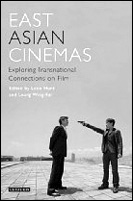East Asian Cinemas: Exploring Transnational Connections on Film
by Jasper Sharp
The academic anthology East Asian Cinemas: Exploring Transnational Connections on Film covers a pan-Asian cinematic output while acknowledging in its introduction that 'Asia' as a concept is "a free-floating signifier - a term the exact meaning of which is not yet settled" [pg 5]; in other words, the culture, history, politics and sense of shared values and identity of a region that encompasses Tokyo, the Philippines, Thailand and China, bares little correspondence with, for example, Europe. 'Asian cinema' as a brand might be currently viewed as an alternative to American or European cinema, and the Hollywood aesthetic might well have become considerably more "Asianized" over the past decade or so, but what exactly this means in practice is the subject of considerable debate, a debate in which the various writers in this anthology fruitfully engage.
As is usual for books of this nature, the quality of the individual essays is variable, and I won't deny there aren't some mistakes here and there, but the standard is high overall, and the editors should be particularly congratulated for the way the individual sections nicely link up with one another to ensure that the book as a whole adds up to far more than the sum of its parts. There are plenty of fascinating facts and insights contained within these pages to inspire further directions for research. David Desser's "Remaking Seven Samurai in World Cinema", for example, mentions the attempts of Masaichi Nagata of Daiei and Run Run Shaw of Shaw Brothers to establish the first Southeast Asia Film Festival in 1954, while Gary Needham's "Fashioning Modernity: Hollywood and the Hong Kong Musical 1957-64" covers Hong Kong co-productions with other countries, including Britain and Japan, and looks at how the industry drew inspiration from foreign productions to create its own borderless world not dissimilar to that being portrayed in Hollywood films.
Of particular relevance to Japanese film scholars is Rayna Denison's "The Language of the Blockbuster: Promotion, Princess Mononoke and the Daihitto in Japanese Film Culture" and Gary G. Xu's "Remaking East Asia, Outsourcing Hollywood", which covers Roy Lee and the remakes of The Ring, The Grudge et al. The role of Western personalities such as Quentin Tarantino and Luc Besson in bringing the East to the West is also covered, in Nikki Lee's "Salute to Mr. Vengeance! The Making of a Transnational Auteur Park Chan-Wook" and Leon Hunt's "Asiaphilia, Asianisation and the Gatekeep Auteur: Quentin Tarantino and Luc Besson."
All in all, East Asian Cinemas: Exploring Transnational Connections on Film does exactly what it says on the cover, providing a revealing and much-needed look at how the various industries that make up the catch-all term of "Asian Cinema" relate to each other, as well as to the rest of the world.
